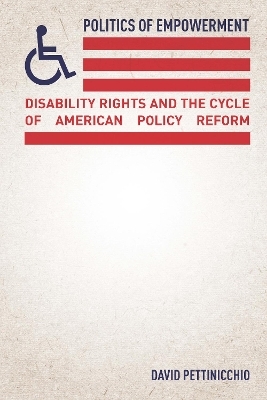
Politics of Empowerment
Stanford University Press (Verlag)
978-1-5036-0087-4 (ISBN)
Despite the progress of decades-old disability rights policy, including the landmark Americans with Disabilities Act, threats continue to undermine the wellbeing of this population. The U.S. is, thus, a policy innovator and laggard in this regard. In Politics of Empowerment, David Pettinicchio offers a historically grounded analysis of the singular case of U.S. disability policy, countering long-held views of progress that privilege public demand as its primary driver.
By the 1970s, a group of legislators and bureaucrats came to act as "political entrepreneurs." Motivated by personal and professional commitments, they were seen as experts leading a movement within the government. But as they increasingly faced obstacles to their legislative intentions, nascent disability advocacy and protest groups took the cause to the American people forming the basis of the contemporary disability rights movement. Drawing on extensive archival material, Pettinicchio redefines the relationship between grassroots advocacy and institutional politics, revealing a cycle of progress and backlash embedded in the American political system.
David Pettinicchio is Assistant Professor of Sociology at the University of Toronto and affiliated faculty in the Munk School of Global Affairs and Public Policy.
Contents and Abstracts1The Political Evolution of Disability chapter abstractChapter 1 outlines the key tenets of the book's thesis: that disability rights entered into an already-defined agenda space revolving around social services and vocational rehabilitation. It did so by way of political entrepreneurs incrementally carving a path for rights to develop. These policies empowered a group of Americans once thought of exclusively as clients deserving of social services to be citizens entitled to civil rights. But, while it began as an elite-driven movement, disability rights would soon be threatened by policy rollbacks and retrenchment that ultimately mobilized a constituency to defend against these attacks. The political evolution of disability rights therefore provides an opportunity for contextualizing—in terms of time and space—the relationship between social movements, political entrepreneurship, policy shifts, and organizational transformations in the broader struggle for civil rights.
2It's Ability, Not Disability, That Counts chapter abstractChapter 2 further contextualizes the evolution of disability rights by examining the service-provision-dominated policy agenda in the first half of the twentieth century. Until the 1960s, a disability policy monopoly promoted a policy image emphasizing ability over disability—the idea that rehabilitation was necessary to overcome disability and create "good citizens." The chapter investigates the kinds of institutional constraints that prevented any significant policy reforms, requiring elites to pursue incremental policy changes. Political entrepreneurs championed the removal of architectural barriers, promoting equal access by using existing rhetoric about economic self-sufficiency through rehabilitation—and consequently laying the groundwork for rights to flourish. Ultimately, their efforts also helped frame the plight of a heterogeneous group as the common struggle of a community.
3Reshaping the Policy Agenda chapter abstractChapter 3 provides a systematic analysis of the kinds of institutional changes that helped political entrepreneurs extend the political discourse around disability to include civil rights. Beginning with the Great Society, the 1960s and 1970s saw an increasing number of congressional committees and administrative agencies involved in disability issues. While this helped gain disability a place on the agenda, it also generated conflict as different policy frameworks clashed. The chapter draws on the equal rights to transit debate as an example. Chapter 3 also points to the consequences of legislative change: that the way actors went about promoting a new logic around "the problem" of disability shaped policy outcomes, backlash, and most certainly the tools and motivations available to a political constituency to push for their rights. And, in mobilizing against political, economic, and social institutions, the disability rights movement necessarily challenged cultural understandings and meanings of disability.
4How Disability Advocacy Made Citizens out of Clients chapter abstractChapter 4 explains how disability organizations and policy coevolved. In the 1970s, the disability organizational sector underwent an advocacy explosion, as it adapted to a new rights-focused policy environment. Existing service-provision groups adopted political advocacy, alongside a proliferation of new advocacy organizations. The chapter illustrates the interdependent relationship between disability organizations and political entrepreneurs in protecting and advancing disability rights, especially when faced with growing backlash and political threats. Chapter 4 uses the transit debate, as well as educational mainstreaming, to situate the growing demand for advocacy as sympathetic elites confronted attempts to roll back rights. Changes in the disability voluntary sector encouraged the expansion of new mobilizing structures that would bring activists together.
5Politics Is Pressure chapter abstractChapter 5 looks at the rise of disability protest in the context of political threats to existing disability rights legislation. The disability rights movement in the government reflected critical structural and organizational transformations that politicized a constituency. Political entrepreneurs supplied the policy instruments around which disability groups helped mobilize everyday citizens with disabilities to champion their rights. The use of extra-institutional, disruptive tactics was not only necessary when institutional means became less available; it also drew public attention to the kinds of inequality disabled people faced. Educational mainstreaming, equal access to transit and Medicaid, and in-home care serve as salient examples of the decades-old unsettled issues that generated uncertainty and back-stepping, which fueled contentious politics and mobilized a movement. Chapter 5 points to this critical transformation in disability rights from an elite-driven movement in the government to a broader grassroots movement in the streets.
6Empowering the Government chapter abstractChapter 6 returns to the reasons why the disability rights struggle is, to this day, a story of unresolved policy entrenchment. The chapter highlights ongoing debates about integrating students with disabilities into regular classrooms and the continued fight over community-based care—key movement issues that are in deadlock. The same institutional configurations that allowed for policy innovation and political entrepreneurship also led to conflict, obstruction, retrenchment, and undesirable policy consequences. Indeed, the case of disability rights reveals the ways in which the duality in America's political institutions creates both the resources and the motivations for citizen action. The chapter speaks to current efforts to undermine policies like the ADA that are rooted in their political development, negotiation, compromise, and lack of enforcement. It also sheds light on the status of the disability rights movement today and the importance of citizen engagement in this civil rights struggle.
| Erscheinungsdatum | 23.10.2018 |
|---|---|
| Verlagsort | Palo Alto |
| Sprache | englisch |
| Maße | 152 x 229 mm |
| Themenwelt | Sozialwissenschaften ► Politik / Verwaltung ► Staat / Verwaltung |
| Sozialwissenschaften ► Soziologie ► Allgemeine Soziologie | |
| ISBN-10 | 1-5036-0087-4 / 1503600874 |
| ISBN-13 | 978-1-5036-0087-4 / 9781503600874 |
| Zustand | Neuware |
| Haben Sie eine Frage zum Produkt? |
aus dem Bereich


